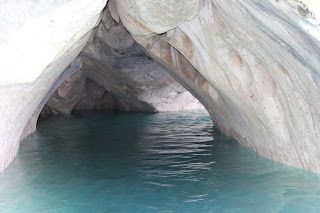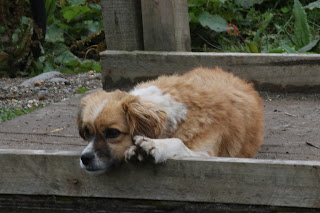The
Carretera Austral or ‘Southern Highway’ stretches for over 12,000 kilometres
through the wettest, greenest, wildest region of southern Chile and is trailed
as one of the world’s most scenic road trips. Our journey along this route
began on Tuesday 13th February after leaving the border town of
Chile Chico.
Chile
Chico sits on the shore of Lago General Carrera, a huge and beautiful lake
which it shares with Argentina (where it is known as Lago Buenos Aires) and in
order to join the Carretera Austral it is necessary to drive 120 kilometres
around a huge section of the lake. It was a good dirt road although quite
narrow and vertiginous in places.
However, we had the most wonderful views of the aquamarine lake, the
black snow-capped mountains and the verdant green of the forests and we both
agreed that this was the most beautiful road we have ever driven.
On the road from Chile Chico around Lago General Carrera
View of Lago General Carrera and mountains beyond
Deep river gorge leading to the lake
Lunch stop by the lake
Local flora
Capillas de Marmol
Capillas de Marmol
Capillas de Marmol
There were pinnacles, columns, peaks, peep-holes and caves into which we could take the boat and the colours were everything from the creamiest cream through to startling pink and green and brown. The lake itself was of the most beautiful turquoise blue and when the sun shone, and mercifully it did for us, the reflection of the light from the water onto these marble swirls and decorated pillars, columns and ceilings was quite startling.
Capillas de Marmol
Capillas de Marmol
By
Wednesday evening we had reached the small town of Cerro Castillo which sits at
the bottom of the mountain from which it takes its name. Unfortunately, we could not see the mountain
because it was entirely shrouded in mist and cloud. Luckily the sun shone next
morning and so we climbed up the hill and had a wonderful view of the mountain
with its sharp castellated ridges and attendant cloud.
Cerro Castillo
Back
on the road again we encountered tarmac for the first time since we set off from
Chile Chico which was very welcome. We drove through forests and for much of
the time following the course of a river.
We
arrived in the small city of Coyhaique on Thursday where we stayed for a couple
of days to stock up on provisions, do the usual admin and get an oil change for
Footloose Lucy.
Whilst
we were in Coyhaique we met an interesting guy by the name of Tim. Originally from Hampshire, Tim has lived and
worked in Coyhaique for the past fifteen years and gave us all sorts of useful
information. He also happens to be a
part time guide at an estancia some 50 kilometres or so from Coyhaique where
condors roost.
We duly arranged to go to the estancia with Tim to see the condors early on Tuesday 20th February. Having achieved all that we needed to in Coyhaique we spent the intervening couple of days at a lovely cabana in the countryside a few kilometres from the city. It was situated in a semi meadow which was covered in wild flowers and with views across to the mountains and down to the small but pretty Rio Baguales below us.
The
owner of the cabana told us that the Rio Baguales was full of small but very
hungry trout and he was right. We walked
down and spent a morning there during which time Alan caught three fit and
feisty trout, each weighing about three quarters of a pound. He also cast a fly or two in the much larger
Rio Simpson, said to be full of very large trout, but had zero success.
Rio Simpson
We
left the cabana on Monday and then drove along dirt road to a dried up river
bed which Tim had told us about which was close to the estancia. There we set up camp for the night and, as it
was very cold, we lit a campfire and we sat round it and had our supper and
then chatted until about ten o’clock by the glow of the fire.
Bush camp near Estancia Punta del Monte
Keeping warm by the campfire
During
this time a couple of vehicles went past, that was about it, but then just
after ten o’clock the police arrived with their lights flashing and required us
to put the fire out forthwith which we did with their assistance. We were about
to go to bed by then, so the fire had pretty much died down anyway.
The
bonus was that once the fire was out and the constabulary had departed, lights
still flashing, we stood and looked at the sky, a wonderful clear sky, no
ambient light whatsoever and a million stars!
Alan saw one shooting star, we saw the Milky Way as clear as it is
probably possible to see it, a great white swathe of a million, million stars
crossing the sky. We saw Orion and we
stood for about half an hour just gazing up in wonder.
Dawn at the bush camp
A little later
Jagged mountain top, condor roost
Windswept mountain top vegetation, living and dead
Adult male condor
Adult female condor
Adult male condor
On the
way back Tim took us to a field on the estancia which is archaeologically
unique. It’s a place where the
indigenous Indians used to gather and work stone tools. We found obsidian which apparently is not
found closer than a thousand miles from that location along with other quartz
like stones, all of which had been worked.
He also showed us another place that was full of fossils. Many of them
were like tiny starfish and there were other worm like casts and these were all
presumably from the sea bed when the area was a shallow tropical sea, hard as
that was to imagine.
Fossils of starfish like creatures
Armadillo seen on the estancia
Finally,
Tim led us to a very pretty river and after a bit of struggling we got down to
the banks. The river was undoubtedly
full of fish, they were jumping all over the place but none of them was the
least bit interested in any of the fly that Alan cast.
Tuesday
turned out to be a very long day so we had one final night at the cabana before
setting off north again on the Carretera Austral on Wednesday morning.
It was
not long before there was a large diversion in place on the Carretara Austral
and we were sent along a winding back road through the mountainous countryside.
At the bottom of every valley there was a beautiful river, many of them wide
and some of them small, full of boulders and chuckling little cascades. The sides of the valleys led up to the
mountains and these mountains were covered in trees, many of them apparently
growing from the vertical rock sides. The
course of the road, which was all dirt and quite narrow in places, wound continuously
from left to right and up and down like a big dipper. Inevitably we didn’t make quick progress but
the drive was quite beautiful.
Typical view from the Carretera Austral
Just another waterfall
Viaduct on the Carretera Austral
After
stopping for the night at a pretty little campsite in the village of
Manihuales, we continued north on a paved section of the Carretera Austral and
then stopped to camp the following night on the banks of a fjord close to
Queulat National Park.
On Friday morning we packed up and went into the national park which is full of extensive evergreen forest but also a spectacular hanging glacier. The glacier protrudes from a high valley from the bottom of which issue a number of snow melt waterfalls which go down into a large glacial lake.
Hanging glacier with waterfall
Hanging glacier
Snowmelt river fed by hanging glacier
Glacial lake with glacier in the background
Sue on the hanging bridge
Having
seen all we wanted to in the National Park we then travelled the short distance
to the delightful little town of Puyuhuapi which sits at the head of the fjord. It is a quiet, gentle place and we have spent
a wonderful couple of days respite here.
We spent several hours yesterday kayaking along a beautiful stretch of the fjord and when we stopped for our picnic lunch we were entertained by three dolphins who cavorted about 50 metres from us for about half an hour.
Sunset over Puyuhuapi fjord
Boat no longer seaworthy, Puyuhuapi
Bored puppy
Local cottage, Puyuhuapi
We spent several hours yesterday kayaking along a beautiful stretch of the fjord and when we stopped for our picnic lunch we were entertained by three dolphins who cavorted about 50 metres from us for about half an hour.
Kayaking on the fjord
Lunch stop on the fjord (dolphins just visible)
Tomorrow
is Monday 25th February and our plan is to get back on the road and continue
the short distance to La Junta where we will be leaving the Carretera
Austral. This is rather sooner than we
had originally intended, the reason being that the road is closed after La
Junta at the village of Villa Santa Lucia.
Just before last Christmas a huge landslide caused by the collapse of a
glacial lake wiped out Santa Lucia along with 60 of its inhabitants and, of
course, the road which has not yet been rebuilt. We understand that we need to go to La Junta
to book a ferry to circumnavigate the area and we are hoping that we can get on
one to the island of Chiloe, but we shall see!




































































